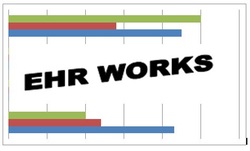
A recent survey conducted for the American College of Physicians and Doctors Helping Doctors Transform Health Care (published October 2012 ) in collaboration with the Bipartisan Policy Center (BPC) revealed some interesting findings concerning physician views about the adoption of electronic health records (EHR).
One of the most encouraging findings is that 80% of physicians surveyed believe that the adoption of EHR is having a positive impact on the quality of patient care. Additionally,
· 80% see EHR as improving the ability to coordinate care;
· 69% believe EHR is improving efficiencies in their practice setting; and
· 57 % see EHR as reducing health care costs.
The same survey was fielded by the American Academy of Pediatrics in September 2012 with similar results. A majority (80 percent) of those surveyed believed that the electronic exchange of health information across care settings will have a positive impact on improving the quality of patient care as well as the ability to coordinate care.
While these percentages suggest an optimistic attitude about the EHR implementation, other findings reveal that there are still areas that need improvement, namely in the ability to exchange patient information among providers. 71% of the physicians surveyed said that the inability of the EHR to communicate electronically with other systems (or lack of inoperability) was a major barrier preventing them from exchanging information, as well as the lack of an exchange infrastructure (71%) and the cost associated with exchanging information (69%).
Fortunately, Stage One of Meaningful Use includes measures for tracking transition of care information exchange, and Stage Two emphasizes the clinical exchange of information electronically. According to CMS, “the Stage 2 criteria place an emphasis on health information exchange between providers to improve care coordination for patients. One of the core objectives for both EPs ... requires providers who transition or refer a patient to another setting of care or provider of care to provide a summary of care record for more than 50% of those transitions of care and referrals.”
Other changes to Stage 2 that demonstrate this objective include:
· EPs that transition or refer their patient to another setting of care or provider of care must provide a summary of care record electronically (>10%)
· EPs that transition care must either a) conduct one or more successful electronic exchanges of a summary of care record with a recipient using technology that was designed by a different EHR developer than the sender's, or b) conduct one or more successful tests with the CMS-designated Test System during the EHR reporting period.
Although the extra documentation may seem time consuming at first, the more familiar systems become and with more feedback from users and providers, the future of EHR looks promising.
One of the most encouraging findings is that 80% of physicians surveyed believe that the adoption of EHR is having a positive impact on the quality of patient care. Additionally,
· 80% see EHR as improving the ability to coordinate care;
· 69% believe EHR is improving efficiencies in their practice setting; and
· 57 % see EHR as reducing health care costs.
The same survey was fielded by the American Academy of Pediatrics in September 2012 with similar results. A majority (80 percent) of those surveyed believed that the electronic exchange of health information across care settings will have a positive impact on improving the quality of patient care as well as the ability to coordinate care.
While these percentages suggest an optimistic attitude about the EHR implementation, other findings reveal that there are still areas that need improvement, namely in the ability to exchange patient information among providers. 71% of the physicians surveyed said that the inability of the EHR to communicate electronically with other systems (or lack of inoperability) was a major barrier preventing them from exchanging information, as well as the lack of an exchange infrastructure (71%) and the cost associated with exchanging information (69%).
Fortunately, Stage One of Meaningful Use includes measures for tracking transition of care information exchange, and Stage Two emphasizes the clinical exchange of information electronically. According to CMS, “the Stage 2 criteria place an emphasis on health information exchange between providers to improve care coordination for patients. One of the core objectives for both EPs ... requires providers who transition or refer a patient to another setting of care or provider of care to provide a summary of care record for more than 50% of those transitions of care and referrals.”
Other changes to Stage 2 that demonstrate this objective include:
· EPs that transition or refer their patient to another setting of care or provider of care must provide a summary of care record electronically (>10%)
· EPs that transition care must either a) conduct one or more successful electronic exchanges of a summary of care record with a recipient using technology that was designed by a different EHR developer than the sender's, or b) conduct one or more successful tests with the CMS-designated Test System during the EHR reporting period.
Although the extra documentation may seem time consuming at first, the more familiar systems become and with more feedback from users and providers, the future of EHR looks promising.
 RSS Feed
RSS Feed